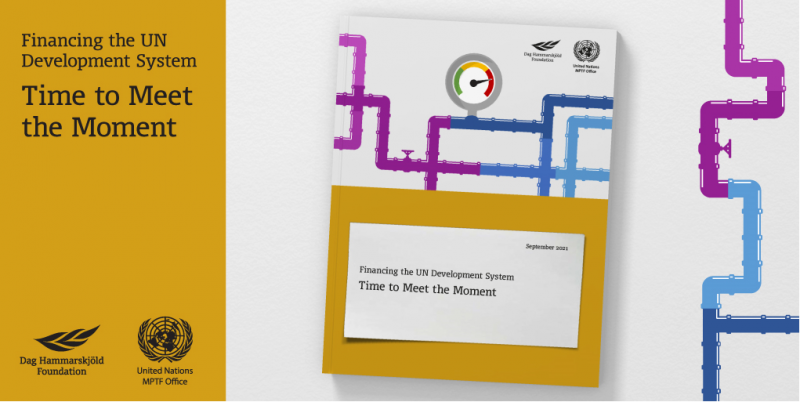

A new report with latest comprehensive data on funding channeled through the UN calls for ‘meeting the moment’ through smart investments and financing for sustainable development, prevention and emergency preparedness.
According to the report Financing the UN Development System, released by the Dag Hammarskjöld Foundation and the UN Multi-Partner Trust Fund Office, the unprecedented challenges facing the UN, such as climate change, the effects of the COVID-19 pandemic, increasing inequality, and armed conflicts are placing unlimited demands on the multilateral system. This requires flexible and predictable funding, the leverage of existing financial resources in-country and the re-emergence of global public goods.
This contrasts with the current financing landscape for the UN. Latest available data on UN funding depicts a highly earmarked and unpredictable funding that limits the ability of the UN to respond to these demands. The report breaks down who is providing funding, who is being funded, and how. It also provides a bird’s eye view of UN spending, following the money as it relates to the UN’s geographic and thematic priorities and reflects the emerging trends, risks and opportunities apparent in multilateral financing.
How is the United Nations funded?
The total revenue of the UN system in 2019—the latest year for which comprehensive data is available—amounted to US$ 56.9 billion, an increase of US$ 0.9 billion compared to 2018. Earmarked funding, which is tied to specific projects, themes or locations, amounted to US$ 32.9 billion, or 58% of total funding. While voluntary, such contributions are restricted in terms of how they can be used by the UN. Voluntary core contributions fell to US$ 5.3 billion, or 9.4% of total UN funding, compared to US$ 5.7 billion in 2018. Predictable and flexible funding, such as core contributions and pooled funds, are essential as they increase the UN’s ability to work efficiently and to adjust its support in times of crisis.
Who funds the UN development system?
UN is largely funded by governments. Almost three-quarters (72%) of total UN revenue in 2019 came from direct contributions by governments. The United States is the largest contributor to the UN in volume. However, relative to the size of each Member State’s economy, countries such as Norway and Sweden
(both of which provide approximately 0.3% of their GNI to the UN) stand out. China has also emerged as a significant contributor to the UN. It is now among the five top Member State contributors and the second-biggest contributor of assessed contributions, which are based on membership fees. China’s contribution as a percentage of its GNI is, however, the lowest among the top ten contributing countries. UN funding from non-state actors remains relatively small (US$ 2.9 billion in 2019) but growing, especially from the private sector.
Where is UN funding allocated?
In 2019, total UN system expenditure was US$ 55.6 billion. Humanitarian assistance expenditure more than doubled in the previous ten years. While the share of humanitarian allocations for the crisis-affected countries grew between 2010 and 2019, expenditure on development and peace activities, remained fairly constant. Over one fifth (21%) of all UN expenditure was allocated to 5 crisis-affected countries (Yemen, South Sudan, the Democratic Republic of Congo, Lebanon and Somalia).
Beyond national interests
Building on this data, the report further presents a selection of contributions reflecting on the emerging trends, risks and opportunities in multilateral financing. For all stakeholders, it is time to ‘meet the moment’ through smart investments and financing for sustainable development, prevention and emergency preparedness, while at the same time managing the COVID-19 pandemic. On top of this, the larger challenge calls for investments addressing climate resilience; the deep inequalities and injustices laid bare by the pandemic; and – through investing in prevention, peacebuilding and sustaining peace – the root causes of conflict.
The report concludes that “knowledge, capacity and financial resources must be made to serve not only national interests, but global needs, norms and commitments”.
Useful links
Interactive report and data: https://bit.ly/3za1Ov4
Report URL (PDF version): https://bit.ly/3AgBiBq
“Who funds the UN?” data visualization: https://bit.ly/3htdItF
“Expenditure in crisis-affected countries” data visualization: https://bit.ly/3z5tt09